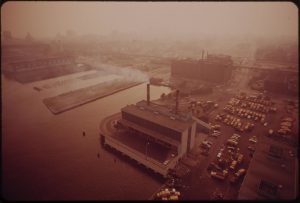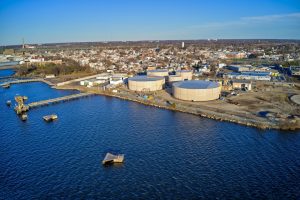Onward! Keeping Up the Momentum in the Delaware River Basin
I’ve worked in watersheds all throughout the western US—the Klamath River Basin in California and Oregon, Walker Lake in Nevada, the Colorado Delta, the Columbia River Basin in the northwest—and they all brought with them interesting challenges, complex landscapes, and most notably, passionate individuals. Their passion came from a truly personal place: a place of home and pride in their natural systems and care for their community. I’m sure many of you can relate to this feeling. As an East Coaster living in a West Coast world, it was difficult for me to find this connection. I would recall the days of sitting on the banks the Delaware River tributary streams that meander throughout my hometown. Eventually, I found myself on my way home to Pennsylvania.

City Incinerator On The Delaware River, August 1973. Photo by Dick Swanson. US National Archives.
Working now in my watershed, it’s hard not to feel that passion and hometown pride – especially with all the recent headlines hailing the successes of the Delaware River Basin, and its many significant achievements in the first half of 2020. A historically heavily polluted waterway with fish dead zones and a smell that would turn any visitor green, the Delaware River is now experiencing significant improvements in water quality and rebounding fish returns. To celebrate these achievements, American Rivers named it the River of the Year for 2020! This is a tremendous honor and well-deserved for the passionate individuals and local groups who have worked non-stop in support of a healthier river for everyone. And, just this April, the New Jersey Department of Environmental Protection granted major protections for 600 miles of waterways throughout the state. This win came after a coalition of conservation groups worked together to garner public support and to submit data to inform the upgrades.
These successes could not have been obtained without land and water protections and enforcement on the federal, state, and local levels, a focused effort on natural systems and green infrastructure, and the commitment of local organizations and advocates pushing for stricter water quality criteria and regulation enforcement. And our job is not nearly done.
As we look forward, we look to one of the most urbanized sections of the mainstem, the Philadelphia-Camden reach of the river. Because of the big improvements over the years, people are gravitating to the water, especially in the warm summer months. Boating and streamside programs are opening up opportunities for people to get out on the water and introducing a little respite of nature sandwiched between two bustling cities. Our partners at Bartram’s Gardens, for example, run free boating programs for the public throughout the summer. Despite the existing recreation, these uses have yet to be recognized from a regulatory perspective. The water quality standards on the books for the Delaware River Basin Commission (DRBC) and the states of Pennsylvania and New Jersey do not yet protect primary contact recreation uses (those uses where risk of ingestion of water is high, like kayaking or canoeing) along the Philadelphia-Camden reach. Which is to say that the current water quality standards do not sufficiently protect the health and safety of everyone who enjoys primary contact recreation activities on this section of the Delaware River.

A refinery on the Delaware River. Photo via Shutterstock.
Under the Clean Water Act, if water bodies are being used for purposes that require better water quality than the current designated uses require, then “the state shall revise its standards to reflect the uses actually being attained” (40CFR131.10(i)). These provisions, which are over 40 years old, are central to the Clean Water Act, and helped the Delaware River achieve its River of the Year honor. Continuing to implement this keystone law makes good sense. Recently, a coalition of environmental organizations submitted the Safe and Healthy Delaware petition to the DRBC and the states of Pennsylvania and New Jersey calling for the recognition of primary contact recreation as a designated use for this section of the Delaware River and to modify water quality standards to better protect the health and safety of everyone who enjoys recreation activities on the river. We’re looking forward to working with DRBC, the states, and others to find a way forward so we continue to see the river and local communities thrive.
How can you help?
If you’re reading this and thinking… wait a second, I was just paddling that river last fall and I didn’t know any of this! Your stories and experiences can help provide support to our efforts to upgrade protections for the waters you love. A team of organizations, including the Delaware Riverkeeper Network, Clean Air Council, PennFuture, Environment New Jersey, and River Network, have created several avenues for you or your organization to get involved.
Sign on in support of the petition, and submit video or written testimonials about how you have used the Philadelphia-Camden reach of the river for primary contact recreation (kayaking, canoeing, stand-up paddleboarding, water skiing, jet skiing). See the links below and this recorded webinar for more information.
For Individuals
For Organizations
Growing up just outside of Philadelphia, I remember days of walking along the riverfront and being in awe of the great river before me. It truly is a great river and, by working together, we will continue to make great strides in improving its quality for all who use it.






Thanks for this wonderful essay, Colleen. I have signed the petition. The Delaware is a terrific river with great potential for recreation and public use right here in its most urbanized section.
Thanks for this wonderful essay, Colleen. I have signed the petition.